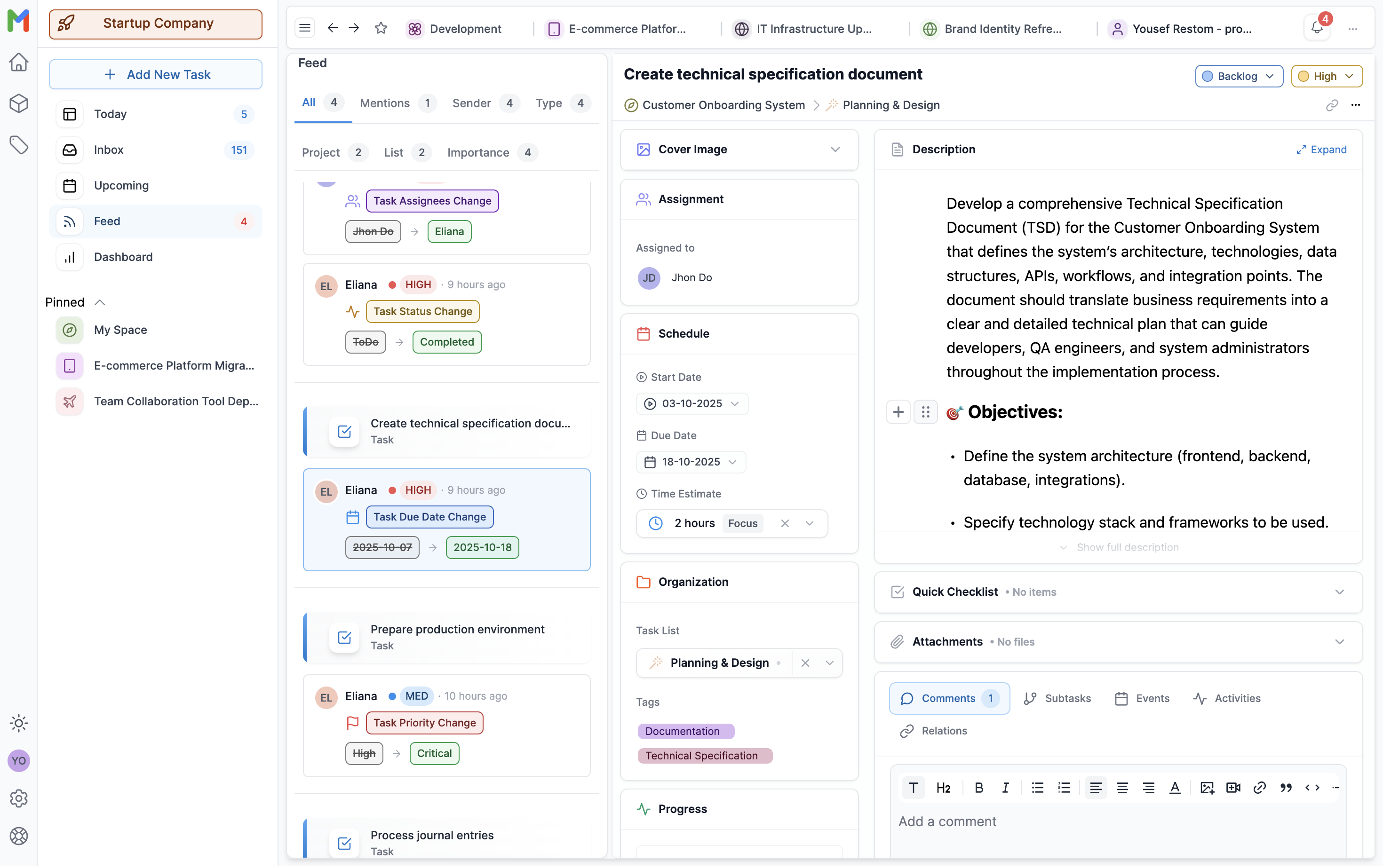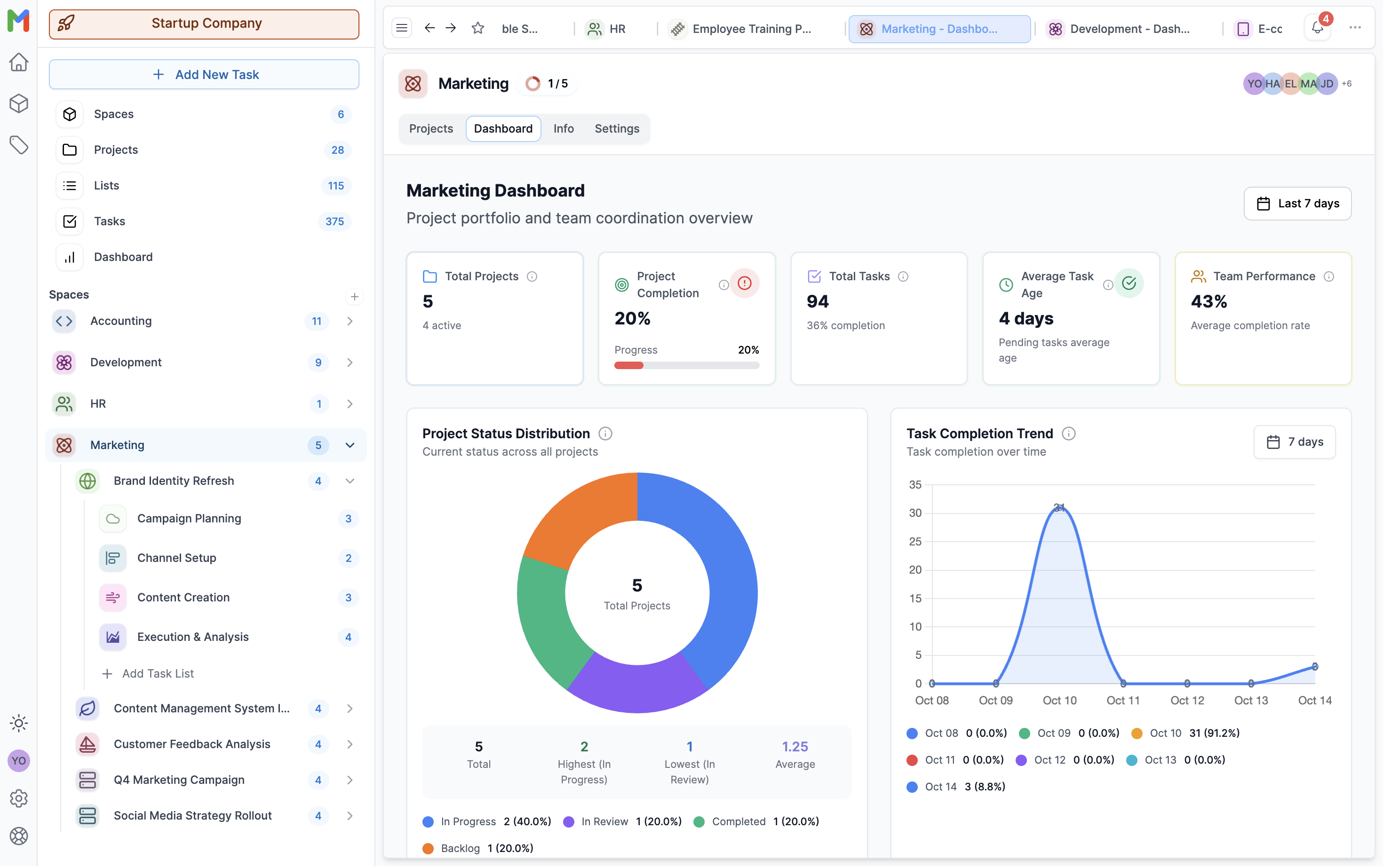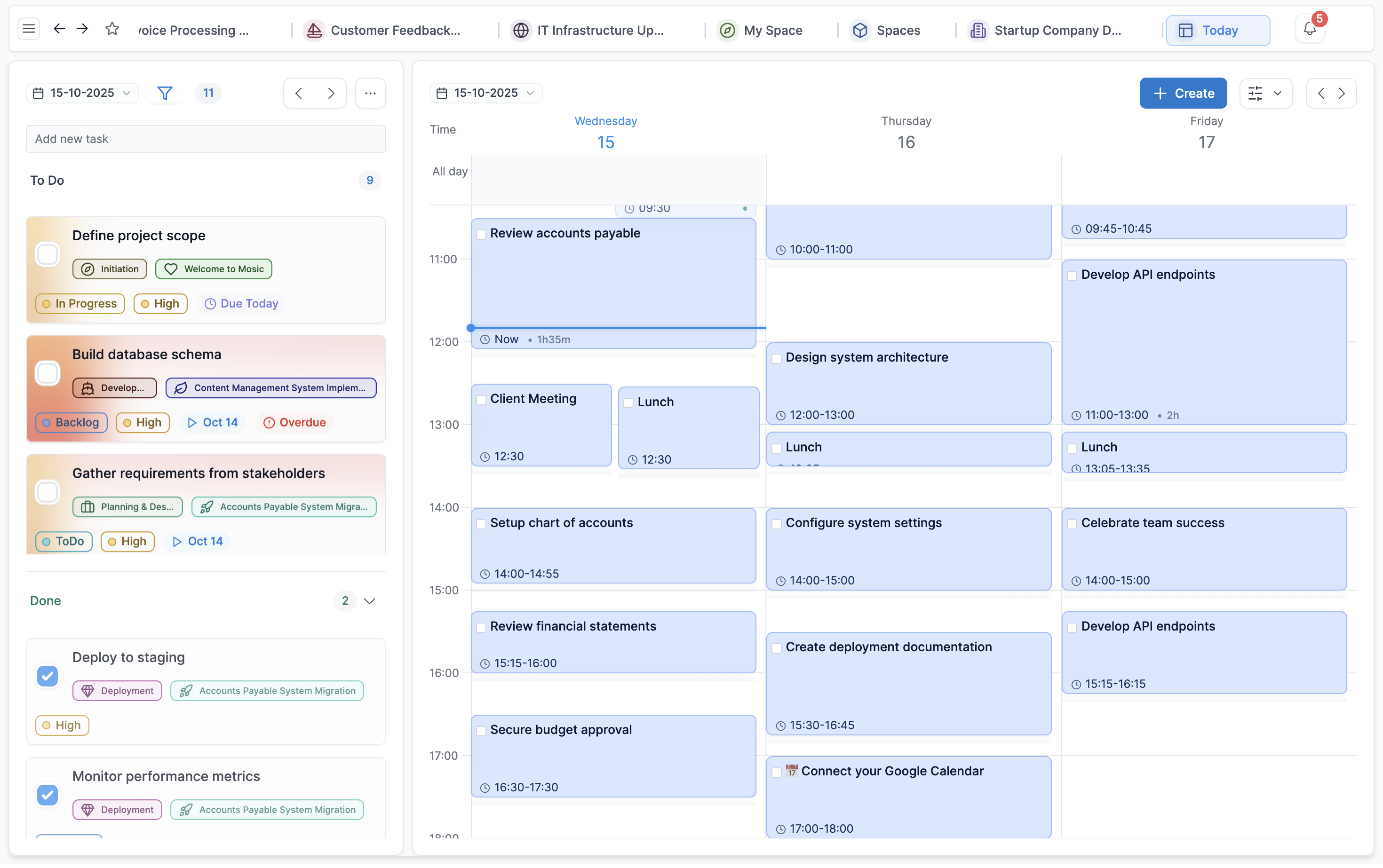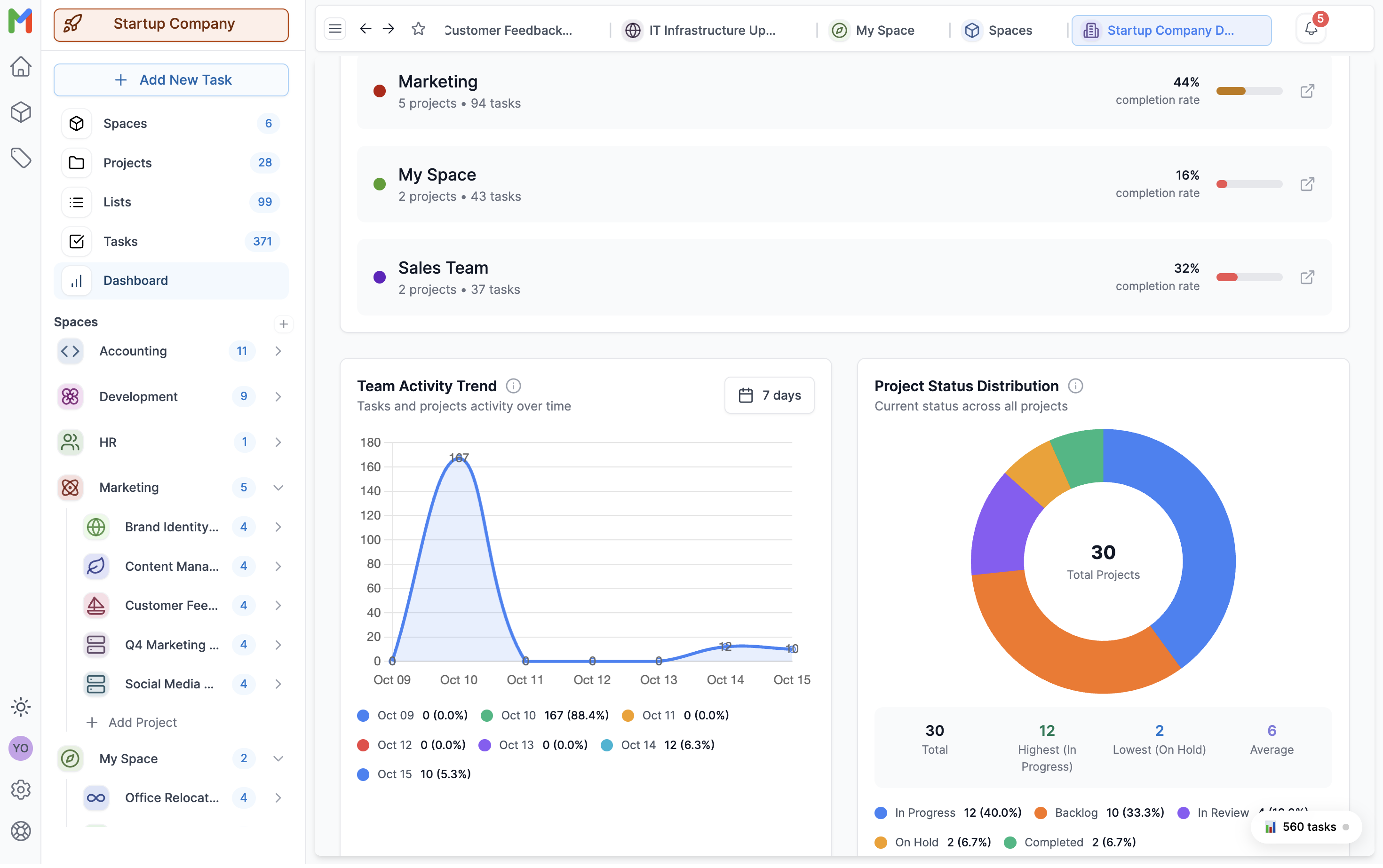Your 5-person team is buried in 'quick syncs.' Monday morning: 'What are you working on?' Wednesday afternoon: 'Did that get done?' Friday: 'What's the status for next week?' Everyone interrupts everyone. Work happens between meetings, not during work hours.
Built for how your team actually works
From solo freelancers to growing teams. Remote, distributed, or hybrid.
See how teams like yours use Mosic to stay organized without the complexity.
Project management tools aren't broken.
They're just designed for someone else's workflow.
Too simple or too complex
You're stuck between task lists that can't handle real projects, or enterprise monsters that require a PhD to operate.
Half the day in status meetings
Your team spends more time talking about work than doing it. "Quick syncs" multiply like rabbits. Everyone asks "what's the status?"
Privacy vs transparency tradeoff
Managing three client projects? You're forced to choose: one messy workspace mixing everything, or constantly switching accounts.
Everything is "urgent"
Your backlog has 47 items from "nice UI tweak" to "production is down." Without clear priorities, every discussion becomes a debate.
Sound familiar?
There's a better way.
Organization without bureaucracy
Mosic gives you the structure you need without the rigidity you don't. Work flows naturally through five simple layers.
Workspace
Your company or team
Space
Department or client
Project
Initiative or campaign
List
Workflow or sprint
Task
Individual work item
Real-Time Updates
Live updates show task changes, comments, and activities as they happen. Activity feed keeps everyone informed without constant check-ins.
6-Level Priority System
Low, Normal, High, Urgent, Critical, Blocker. No more "everything is urgent." Clear priorities drive clear decisions.
Flexible Scaling
Start solo, grow to 100+ without changing tools. Add structure when you need it, not before.
From solo to scaling
One account. Multiple workspaces. Grow without switching tools.
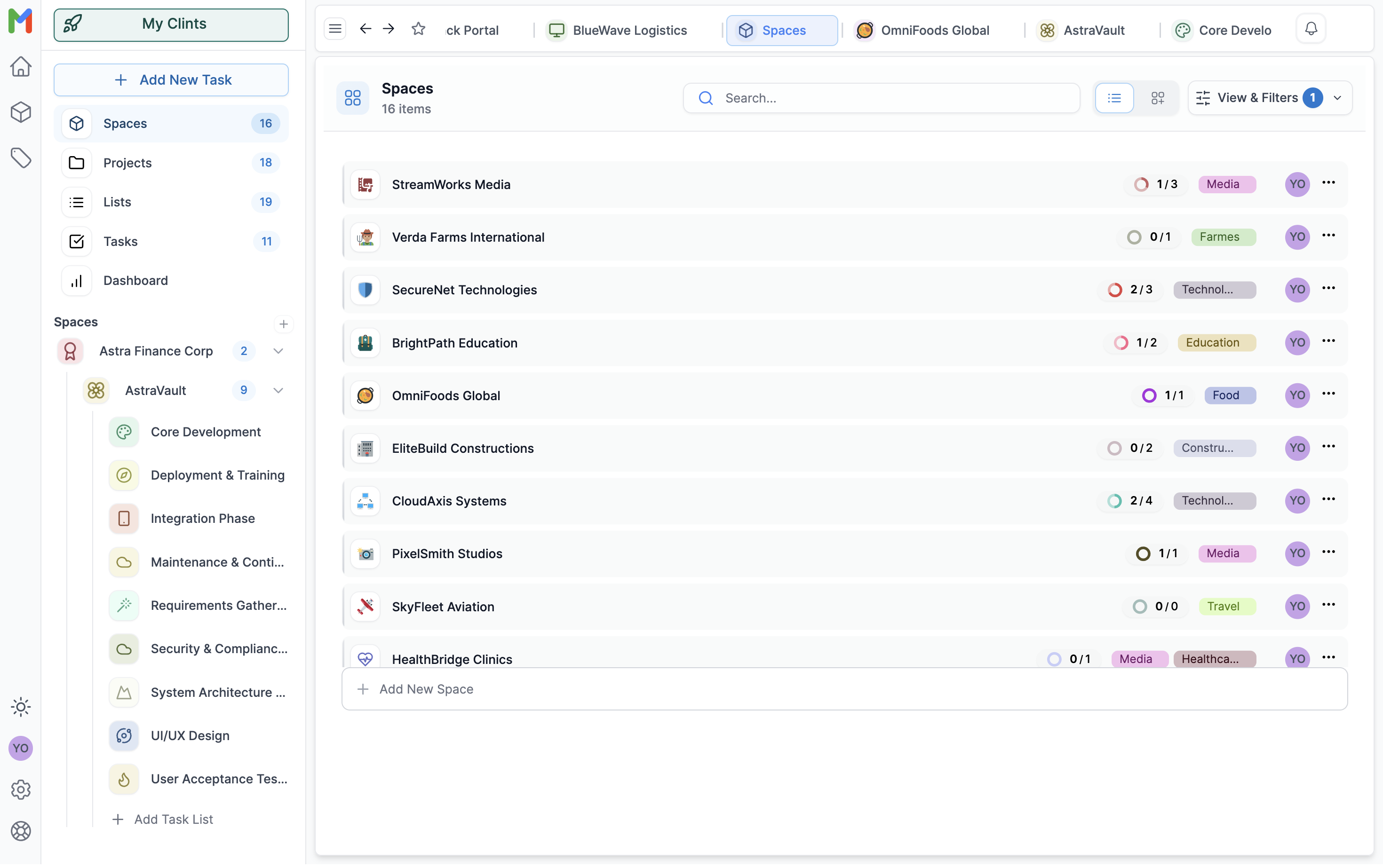
Manage multiple clients without the mess
You're a freelance designer with three active clients. Each has their own deadlines, deliverables, and communication style. Traditional tools force you to choose: dump everything in one space and waste mental energy separating contexts. Mosic gives you separate spaces per client one account, complete isolation, zero context confusion. Switch between Client A and Client B with a single click. Each workspace is its own universe.
Stay organized across clients, maintain professional boundaries, never mix contexts.
Stop asking 'what's the status?' 10 times a day
Real-time updates show changes as they happen, no asking required. Comment threads keep discussions attached to tasks, not lost in Slack scroll. Activity feed with smart filters (All, Mentions, Sender, Type) answer 'what happened today?' in 30 seconds. Async collaboration means people focus on deep work, catch up when ready.
Updates flow through task comments and activity feed. Status is visible without asking. Teams spend less time in status meetings, more time on focused work.
Scale without drowning in process
You're at 25 people. Engineering wants sprints. Marketing wants campaigns. Sales wants pipelines. Leadership wants visibility. Your current tool makes you choose one workflow for everyone, or fracture into separate tools. Adding people means adding process. Structure feels like bureaucracy.
Spaces organize by department (Engineering, Marketing, Sales). Projects group initiatives. Lists organize workflows using the 8 standard statuses. Teams can focus on the statuses relevant to their work. Each team organizes their way within the structure. Dashboard rolls up metrics for leadership. 5-role permission system (Admin, Editor, Member, Viewer, Guest) provides granular access control.
Scale without rigidity. Teams maintain autonomy. Leadership gets visibility. Structure supports work instead of strangling it.
Remote, distributed, or hybrid
Work happens everywhere. Your tools should handle that reality.
Remote Teams
Async feels disconnected. Updates get lost. Nobody knows who's working on what. Information silos form naturally.
Activity feed provides transparency into team activities. Updates show task changes, comments, and status updates. Catch up when you're ready. @mentions create notifications. Real-time updates keep information current.
Distributed Teams
Scheduling across 5 timezones is math homework. Meeting times are always bad for someone. Coordination feels impossible.
Built-in timezone support handles conversions automatically. Schedule events in any timezone, system displays in everyone's local time. Google Calendar integration syncs events. Timeline view coordinates work across continents.
Hybrid Teams
Office workers have hallway conversations remote workers miss. Two-tier system forms naturally. Remote feels like second class.
Same data, everywhere. Activity feed captures all discussions on tasks where they belong. Real-time updates ensure office and remote have identical information. No 'you had to be there' moments.
Built for how you actually work
From agile sprints to marketing campaigns to client deliverables
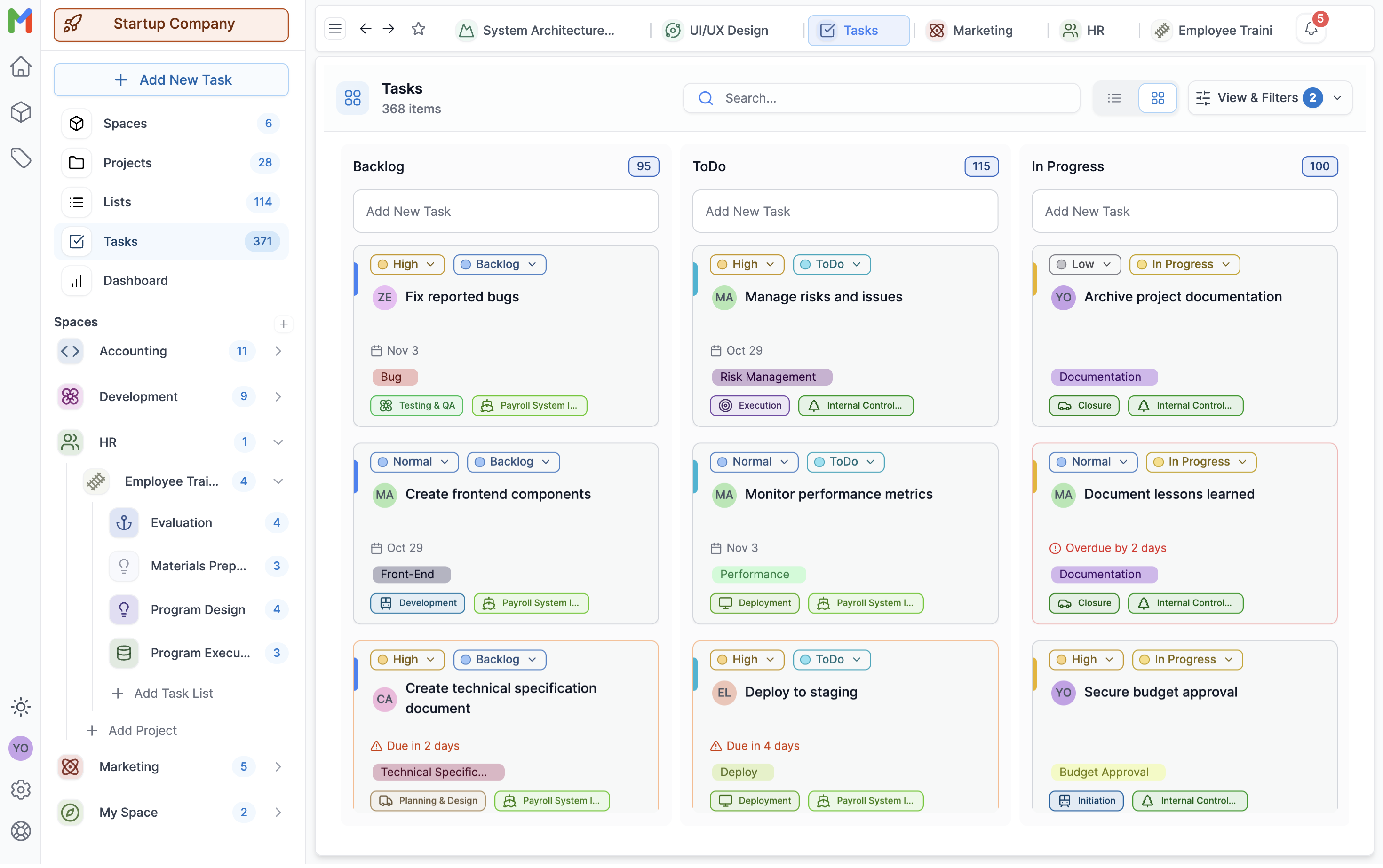
Ship faster when priorities are crystal clear
Monday morning sprint planning. Your backlog has 47 items from 'nice UI tweak' to 'production is down.' Without clear priorities, discussions become debates. Mosic's 6-level priority system (Low, Normal, High, Urgent, Critical, Blocker) provides clarity. Blocker means production is down, stop everything. Critical means launch at risk. Urgent means this week. High means this sprint. Clear priorities drive clear decisions.
Team delivers consistently because everyone knows exactly what matters. Sprint planning focuses on execution, not priority debates.
Launch on time without spreadsheet chaos
Campaign launch next week. Creative is in 'final review' for the third time. Social media copy needs legal approval. Email is half-done. Landing page has placeholder text. Nobody knows who's doing what or what's actually blocking launch. You're managing everything in a spreadsheet that's outdated the moment someone opens it.
One Space per campaign. Projects for each channel (Social, Email, Paid, Web). Lists for workflow stages (Draft → Legal Review → Approved → Scheduled → Published). Calendar shows all milestones in timeline view with hourly grid. Tags mark content type. Assignees clarify ownership. Comments thread approvals directly on tasks, no more email archaeology.
Launch day arrives. Everything's ready. No surprises. Because visibility prevented them. The spreadsheet stays closed.
Confidentiality and visibility, simultaneously
You're managing 8 active client projects. Client A absolutely cannot see Client B's work confidentiality is non-negotiable. Your internal team needs to see everything, capacity planning depends on it. Traditional tools make you choose: complete transparency (violates confidentiality) or complete privacy (blinds your team). Neither works.
Private workspaces per client, or separate Spaces with Guest access within one workspace. Guest users see only their Space, complete isolation. Your team has Member or Editor access across all Spaces, full visibility internally. Tags track billing status (Billable, Internal, Fixed-Price). Dashboard aggregates capacity across all clients while respecting privacy boundaries. 5-role permission system provides surgical control.
Professional boundaries maintained. Client confidentiality guaranteed. Team visibility preserved. All three requirements met, not traded off.
Multiple processes, zero bottlenecks
You're running customer onboarding, vendor management, and compliance audits simultaneously. Each is multi-step. Some steps are parallel, others sequential. Hard to track what's blocked, what's waiting on someone else, what's truly urgent versus just important. Visibility gaps cause delays. Delays cause escalations.
Lists organize workflows with 8 standard statuses (Backlog, ToDo, In Progress, In Review, On Hold, Blocked, Completed, Cancelled). Onboarding tasks move from Backlog → In Progress → Review → Completed. Vendor management follows ToDo → In Progress → Review → Completed. Task relations (Blocks, Blocked By) show dependencies explicitly. Priority system (6 levels) clarifies what needs attention now versus later. Dashboard provides operations overview, see all processes, all statuses, all blockers at once.
Processes run smoothly because bottlenecks surface immediately. Teams know what's blocked and why. No more 'I didn't know that was waiting on me.' Operations scale without adding overhead.
Stop juggling. Start scheduling your day.
You're a freelance designer with three clients and 28 tasks. Every morning: decision paralysis. Client emails arrive, you context-switch. Slack pings interrupt, you switch again. By 3pm, you've answered 40 messages but completed zero designs. Research shows 45% of workers say context-switching kills productivity.
Drag tasks from your Today page directly onto your calendar, turn vague to-dos into scheduled focus blocks. Each block stays linked to its source task, project, and list for full context. Use day theming: Client A on Mondays, Client B on Tuesdays. Your timeline shows exactly when each client's work happens, and your time estimates reveal if you're overbooked before you commit.
Time blocking delivers 80% productivity gains. One designer: 'I went from finishing at 8pm to completing work by 5pm. My clients respect my blocked time, and my work quality improved without constant interruptions.' That stuck logo project? It gets completed Tuesday 9am because it has scheduled time, not vague intentions.
Not just another task manager
We built Mosic because existing tools couldn't handle real-world complexity without becoming complex themselves. Here's what makes us different.
Permission-Isolated Spaces
One workspace with complete departmental or client separation. Guest access per Space, surgical permission control, zero data leakage between areas.
6-Level Priority System
Low, Normal, High, Urgent, Critical, Blocker. End "everything is urgent" debates with objective priority levels.
5-Role Permission System
Admin, Editor, Member, Viewer, Guest. Granular control over Create, Read, Write, Delete, Share, and more.
True Hierarchical Structure
Workspace → Space → Project → List → Task. Five layers that mirror how organizations actually work.
Calendar Integration
Google Calendar integration with timezone conversion, event synchronization, and guest invitations.
Smart Notification System
Intelligent deduplication, priority-based filtering, and context-aware alerts. Never miss what matters, never get overwhelmed.
The Result
A platform that scales from solo to 100+ without losing flexibility or adding complexity
Start organizing work your way
Flexible workspaces, intelligent priorities, and real-time collaboration. Get started in minutes.
